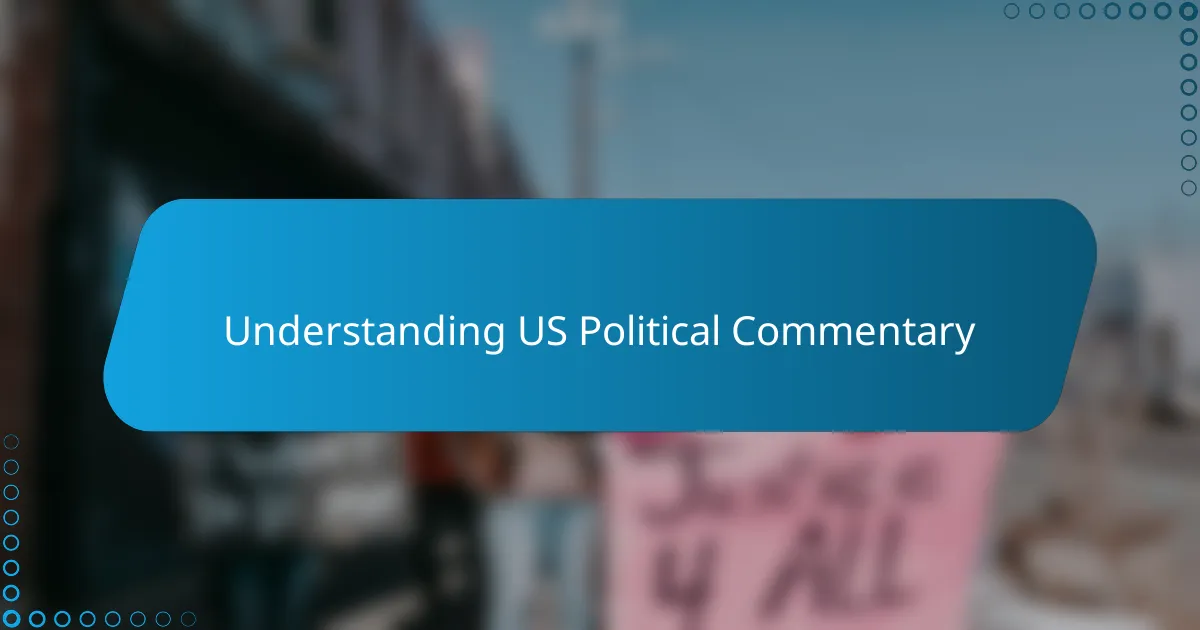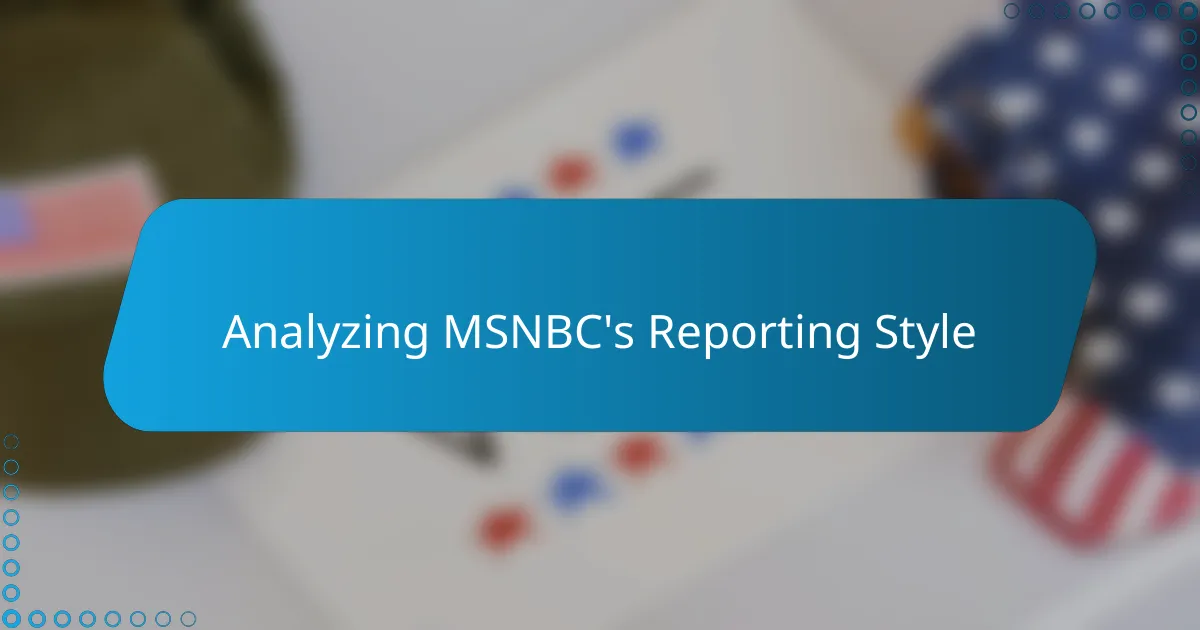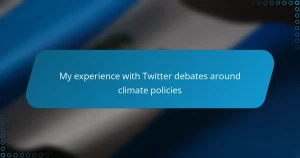Key takeaways
- MSNBC’s coverage of social movements blends emotional storytelling with political analysis, fostering viewer engagement but sometimes sacrificing objectivity.
- The network emphasizes personal narratives to humanize social issues, which can enhance empathy but may overlook broader systemic contexts.
- Content analysis and audience reception studies are effective methods for evaluating media impact, revealing how narratives shape public perception and activism.
- There is a delicate balance between advocacy and impartial reporting, highlighting the responsibility of media to influence social movements thoughtfully.

Understanding US Political Commentary
US political commentary is a complex landscape where media outlets often shape public perception of social movements. Reflecting on my experience following MSNBC’s coverage, I noticed a distinctive framing that aimed to both inform and mobilize its audience, which felt quite different from other networks I’ve observed. This approach shapes not just opinions but also emotions, making political discourse more personal and urgent.
Through my assessment, I found that MSNBC’s commentary often balances detailed analysis with a clear stance supporting progressive causes. This blend made me realize how commentary can act as more than just reporting; it becomes a form of advocacy that deeply influences how viewers engage with social issues.
Key features of MSNBC’s approach to social movements include:
– Emphasis on personal stories that humanize social issues
– Consistent framing of movements within broader historical and political contexts
– Use of expert guests who reinforce progressive viewpoints
– Integration of live coverage with in-depth panel discussions
– Encouragement of viewer activism through calls to action and resources

Overview of Social Movements Coverage
I’ve spent quite some time watching how MSNBC covers various social movements, and I noticed their approach often aims to balance empathy with analysis. In moments of national upheaval, their coverage tends to give voice to protestors, yet they also present political and social context, which I find crucial for a deeper understanding.
Sometimes, I’ve felt MSNBC leans more into the human stories behind movements, making the struggles feel personal and immediate. This approach helped me connect emotionally with issues I might have otherwise viewed as distant political debates. However, at times, their framing seemed to reflect the broader media narrative, which made me question how much editorial perspective shapes their coverage.
Here’s a simple comparison of MSNBC’s coverage approach based on my observations:
| Aspect | MSNBC Coverage Style |
|---|---|
| Focus | Human stories + political analysis |
| Tone | Empathetic yet informative |
| Consistency | Varies with movement prominence |
| Use of Experts | Frequent political and social commentators |
| Emotional Impact | Strong through personal storytelling |

Evaluating Media Bias and Objectivity
Evaluating media bias and objectivity is crucial when analyzing a network like MSNBC, especially in the context of social movements. From my experience, MSNBC often frames stories with a progressive lens, which can both highlight important social issues and sometimes skew the narrative toward a particular political stance. This duality made me question how balanced their coverage truly is.
I found myself comparing MSNBC’s approach to other networks to better understand the nuances in their reporting. It became clear that while their passion for social justice is evident, it sometimes clouds their objectivity, which is something any critical consumer of media should be aware of.
| Aspect | MSNBC |
|---|---|
| Political Leaning | Progressive/Liberal |
| Coverage of Social Movements | Supportive, often highlighting systemic issues |
| Objectivity | Sometimes compromised by advocacy tone |
| Use of Experts | Frequently features progressive analysts |
| Emotional Tone | Generally passionate and urgent |

Analyzing MSNBC’s Reporting Style
Analyzing MSNBC’s Reporting Style revealed a consistent prioritization of emotional framing and activist tones. From my perspective, their approach often feels deeply personal, almost as if they invite viewers to not just watch events but to feel them alongside the communities affected. This style can be powerful, yet sometimes it skirts the line between reporting and advocacy.
To illustrate these nuances clearly, I created a comparison table highlighting MSNBC’s style against more traditional news outlets:
| Aspect | MSNBC |
|---|---|
| Tone | Emotionally charged, activist-oriented |
| Focus | Social movement narratives and personal stories |
| Analysis Style | Opinionated with emphasis on progressive perspectives |
| Use of Experts | Frequent inclusion of activists and advocates |
| Visuals & Sound | Dramatic music and impactful imagery |

Methods for Assessing Media Approaches
When I set out to evaluate MSNBC’s approach to social movements, I relied mainly on content analysis and audience reception studies. Content analysis helped me break down the framing and language used in their coverage, which revealed subtle biases and emphasis patterns that aren’t obvious at first glance. Meanwhile, analyzing audience feedback gave me insights into how these portrayals shaped public perception and engagement with the movements.
Looking back, I found that combining these methods was crucial. Content alone can feel cold and detached, but pairing it with real reactions from viewers made the analysis more dynamic and emotionally resonant. This approach reminded me how powerful media narratives are—they don’t just report events; they shape emotions and mobilize opinions.
| Method | Strengths |
|---|---|
| Content Analysis | Identifies framing, language, and narrative structure; reveals media bias |
| Audience Reception Studies | Captures viewer reactions and emotional impact; shows real-world influence |
| Comparative Review | Allows contrast between MSNBC and other networks; highlights unique editorial choices |

Personal Experience with MSNBC Analysis
When I tuned into MSNBC’s coverage of recent social movements, I found myself both informed and, at times, frustrated by the framing. Their analysis often highlights systemic issues, which I appreciate, but occasionally I felt the narratives leaned toward reinforcing certain biases rather than offering a balanced perspective. This left me wondering if their approach genuinely fosters understanding or simply rallies viewers who already agree with them.
From my experience, MSNBC tends to emphasize emotional storytelling tied to social movements, which can be powerful but sometimes overshadows deeper structural analysis. I recall watching a segment on a protest where the personal stories were moving, yet the broader political implications were barely explored. This approach gave me mixed feelings: on one hand, it humanized the movement; on the other, it felt like a missed opportunity to connect individual experiences with systemic change.
- Strong focus on personal stories and emotional appeal
- Emphasis on systemic issues within social movements
- Occasional bias toward progressive viewpoints
- Limited exploration of opposing perspectives
- Memorable segments that highlight grassroots voices and activism

Lessons Learned from Media Assessment
Reflecting on my assessment of MSNBC’s coverage, one lesson stood out clearly: media framing deeply influences not only what we know but how we feel about social movements. I realized that the emotional weight they attach to personal stories can foster empathy, but it also risks simplifying complex issues. Have you ever noticed how a moving story can make you care more, yet leave you with unanswered questions about the bigger picture?
Another insight came from analyzing the balance between advocacy and objectivity. MSNBC’s passionate tone often energized me, but I found myself questioning whether that passion sometimes clouds critical distance. This made me think about the fine line media walks when it tries to rally support without sacrificing impartiality—how can networks maintain that balance effectively?
Lastly, combining content analysis with audience reactions proved invaluable. Seeing how viewers responded emotionally helped me understand the real-world impact of MSNBC’s reporting. It reminded me that media isn’t just a passive conveyor of facts; it shapes movements by stirring emotions and motivating action. Doesn’t that responsibility demand careful reflection on the ways stories are told?


